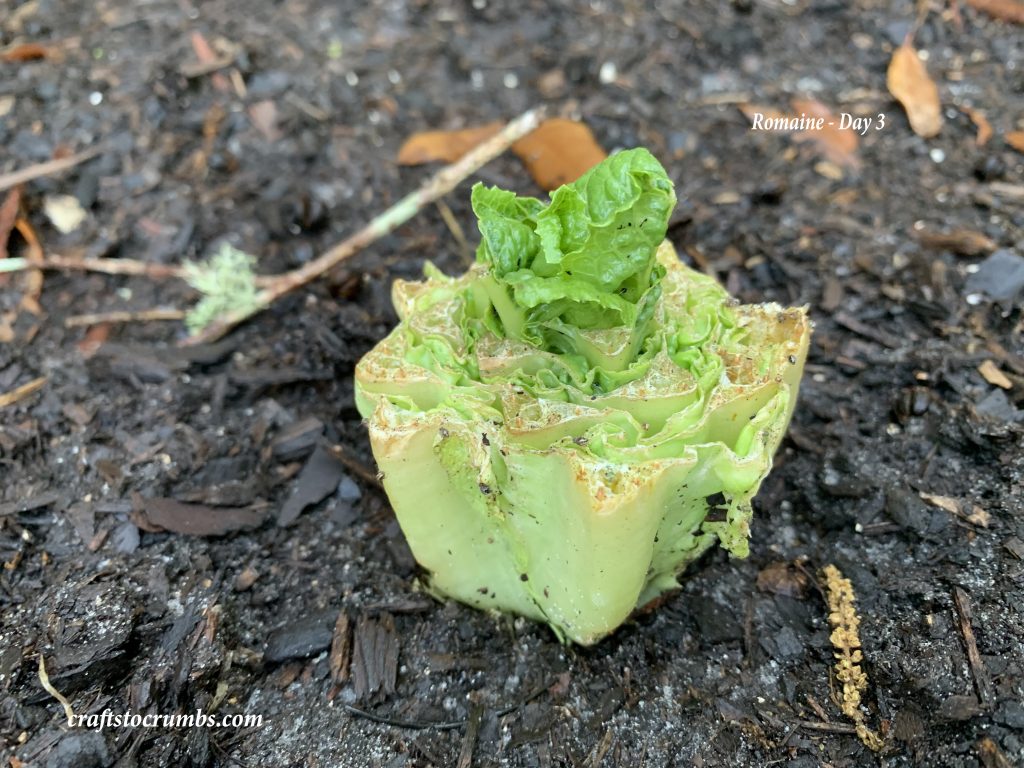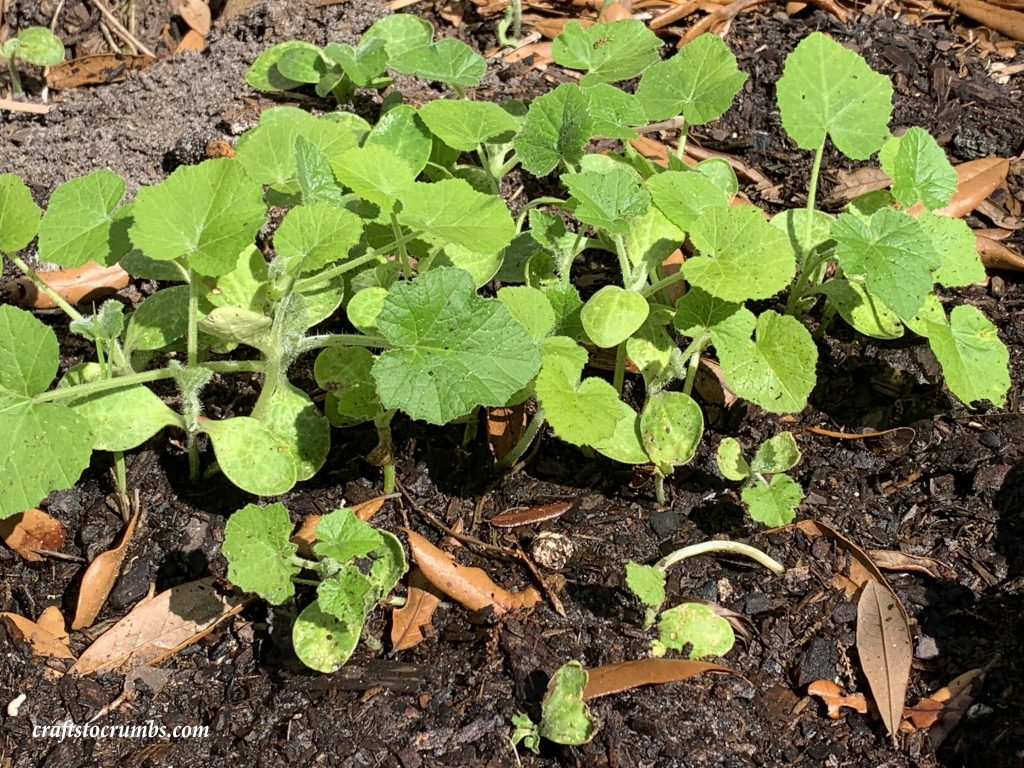Gardening with Kitchen Scraps
People like to associate me with baking. It’s a good activity and I enjoy it a lot, but I can go out to my backyard garden and stay there for hours upon hours and not want to leave. Funny thing is, I don’t consider myself as having “green thumbs” and my garden isn’t some lush jungle. Matter of fact, I tend to be a lazy gardener. You’re not going to find neat rows of vegetables. I want to say I support the forest gardening style. I never found any advantages to segregating plants and when you have a limited backyard space, you make the most use of the space you have.
I love gardening because I enjoy watching plants grow. I enjoy figuring them (plants) out. Do they like sun? Shade? More water or food? Hey, they are living things too! I almost cried when I had to chop down my 11-year-old rose bush after it was struck by lightning and died. My plants are like my pets. They give me an excuse to go outside to get fresh air and sunshine. And you can eat the fruits of your labor. Although I think most of the labor is clearing the garden beds of weeds.
Recently, I started composting. The EPA (epa.gov) has a great guide for composting if you want to start and don’t know how. Make sure you have your brown materials, your green materials and water too! As I mentioned, I can be a lazy gardener and don’t always do a great job of turning the pile sometimes, but I started noticing certain scraps will grow. Even if you cut them down to a nub, they will grow!
So, I’m sharing some of my observations and things I’ve learnt over the years from my parents, who always had a garden. You can regrow or compost. Reduce and regrow! This is by no means, a comprehensive list, but it is some of what I’ve been working with.
Plants you can grow from scraps – usually the ends
• Carrots – Cut and leave an inch or so at the end. Maybe slightly bigger pieces than if you were to compost them. You can plant that end directly into the ground and it will start growing greens. Keep in mind these might not look as pretty as carrots that you grow seeds. Carrots take 70-80 days to mature. You’ll want to start these early.
• Cabbages – plant the outer most leaves with the bottom end and core. I had a core that I planted around the holidays. So far, it has survived the winter! Only a few more days of winter to go and look at how beautiful my cabbage plant is. These guys like fertile soil and lots of sunshine, but they do well with partial shade as well.

• Bok choy – I love baby bok choy and I didn’t think I could grow them this easily but cutting the white ends and burying the ends slightly in dirt works! And just like cabbages they like fertile soil and partial shade.
• Lettuce – Cut the ends and bury them slightly…and I mean slightly. You can practically just sit them on top of dirt, and they will grow. Some people grow them in water indoors, but I hate keeping the water clean. This is possible the fastest growing scrap. You will notice growth within days. The baby lettuce leaves can be used for lettuce wraps or if you have enough you can even add to a salad. The picture of the lettuce below is one that has been “planted” for two days.

• Celery – Like the lettuce and bok choy, you can cut the stalks off celery and they will sprout from the ends. You may have seen celery growing on water as a science project, but they do well in dirt where they belong. I had a celery plant growing next to my cabbage, but there were a few days when the temperature dipped a bit this winter and I lost that celery plant. It would be a great one to have in the garden considering how often I cook with celery. I’m going to re-grow celery in the spring and summer.
• Onions – cut the root end of an onion and start a new onion. You don’t need much. The very end with root is enough. Although, fair warning, it will take months until you get a full-size onion. However, if you can’t wait that long, you can always enjoy the green onions. Speaking of green onions, people tend to re-grow green onions in a glass of water, but that is completely unnecessary. You can stick that cutting straight into the dirt. Just make sure to keep it moist.
Plants propagated from bulbs or cuttings
• Shallots and garlic – After shallots and garlic age they start to germ, meaning they have that green growing in the center. That green germ is the beginning of a new plant. Wait a little bit longer and you’ll notice that they’ll sprout like a green onion. You can plant a whole shallot that has germed. For garlics, you can break the individual cloves up and plant them. Green garlics look like green onions, but they taste milder with less bite. They are a great alternate and more pleasant when eaten raw.
• Galangal and ginger – make sure you find a piece that is healthy, at least 3 inches. They should have the eye of new growth, which looks like little horns or pointy ends. That’s where the new growth will sprout from. Pick a good piece and make sure this end is pointing up when you plant it. They like moist soil, but don’t over water them. That could cause root rot. When I buy galangal from the Asian market, they usually come in packs with multiple pieces. I cook with the smaller ones. Chop some up and freeze them for another day. Pick the healthiest piece for planting.

• Lemongrass – speaking of things from the market that you can stick in the ground and it grows, lemongrass is probably one of the easiest ones. I have a few small bushes growing and they all started with two stalks. I bought a pack of 4 lemongrass stalks over a decade ago. Cooked with two stalks and stuck the other two in the ground where I knew it would get watered by the sprinklers. All my lemongrass bushes are strategically placed where they will get water from one of our sprinklers. I’ve never purposefully watered my lemongrass and my backyard has not been without lemongrass in over a decade. The only time I buy lemongrass nowadays is if I’m cooking a ton and I need my bushes to recover from my last cooking adventure.
• Potatoes – Literally stick them in the ground! A plant will grow upwards, the roots will grow outwards and new potatoes will grow all along the roots. Peanuts grow the same way. If you have bigger russet potatoes, you can cut them up into halves. Cover them with a few inches of dirt and space them about a foot apart.
Plants from seeds
• Papaya seeds – Taken from the ripen fruit. You want to make sure your seeds are black and not the white seeds that you would typically see with the green papaya. Dry the seeds and plant them. Simple as that. I would collect as much as I can because you’ll want to plant more than one seed. They have male, female and asexual plants. If you get a male plant, you’ll never get fruits. So, planting more than one increases your chances of getting papaya fruits. These do better in warmer hardiness zones in full sun.
• Tomatoes – That old tomato no one is eating. The tomato on your salad. The slice of tomato on your fast food hamburger. They will all sprout into new tomato plants. No need to spend additional money buying the seeds. Take them from your food source. I have several tomato plants growing right now. We had a mild winter and I have some that survived the winter. I might have some ripe grape tomatoes by the time spring gets here!
• Peppers – Whether Thai chili, bell peppers or any other peppers. Take the seeds from the ripe pepper dry them out and plant them. There were a few occasions last year when I found my chilies knocked off the plant and I stuck them straight into the dirt if I’m not cooking with them. The Thai chili casings are thin, and they don’t take long to decompose. I have so many baby pepper-plants this year. I need to re-pot some of them. I know people treat these like annuals, but I’ve had both my larger pepper plants for years. I keep them in planters under the covered patio, close to the house and they do just fine through the winters.
• Long beans – I love the Asian long beans. You can stir-fry them or eat them raw. We like to use them for thum mak thua (muddled long beans). I’ve had these in the garden for the past few summers. To collect these seeds, I let a few long beans grow old and dry on the vine. Once they start to dry out and the pods aren’t green anymore, I’d pick them and sometimes let them dry out a bit more. And we have seeds for next growing season.
• Pumpkins – Pumpkins usually have so many seeds. After carving that jack-o-lantern, you can have some roasted pepitas and save a few seeds on the side for growing the following season. Make sure you plant these by flowers that will attract bees because bees are one of their main pollinators. To make matters more interesting, pumpkin blossoms only bloom for a couple hours in the morning. If you don’t get pumpkins, stuff those blossoms and fry them! Don’t stress it! 😊 But start them early, two to three weeks before the last frost. You can start the seeds indoors if you are in a cooler hardiness zone.

Well, these are a few of the things I have growing in my garden. I hope this has inspired you to (re)grow something. Go outside and get some sunshine!


Zay . I have been reading about all of your gardening. Sure makes me homesick for some place to grow stuff like Jack & I use to have but life goes on
I miss him. I grow okra every year because it reminds me of him. 🙂